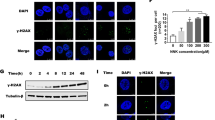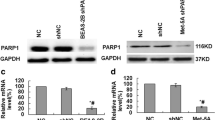Abstract
Benzo[a]pyrene is a ubiquitously distributed environmental pollutant known to cause DNA damage, whereas PARP-1 is a nuclear enzyme that is activated by damaged DNA and plays an important role in base excision repair and genomic stability. Here, 16HBE and its PAPR1-deficient cells were exposed to BaP, and the DNA damage level and repair ability of both cell lines were measured by alkaline comet assay. The results showed that cell viability of both cell lines decreased in a dose-dependent manner when exposed to BaP, but there was no significant difference between two cell lines. Comet assay showed that BaP caused DNA damage in both cell lines at an obvious dose- and time-dependent manner. Compare with 16HBE, the PARP1-deficient cells were more sensitive to the damage caused by BaP. The results of DNA repair experiment showed that both cell lines can recover from the damage in a time-dependent pattern. The relative repair percentage of PARP1-deficient cells were generally lower than that of 16HBE at all exposed concentrations at the early stage of repair, but tended to be closer between two cell lines at the later period. According to results, we came to the conclusion that PARP1-deficient cells were more sensitive to BaP in contrast to normal 16HBE; DNA repair capacity in PARP1-deficient cells decreased significantly at the early stage of repair, but increased to the equivalent level of normal 16HBE in the later period. PARP-1 plays an important role in early repair of DNA damage caused by BaP in 16HBE notwithstanding the main repair work is taken by NER pathway.







Similar content being viewed by others
Abbreviations
- BaP:
-
Benzo(a)pyrene
- PARP-1:
-
Poly(ADP-ribose)polymerase-1
- HBE:
-
Human bronchial epithelial cell
- BER:
-
Base excision repair
- BPDE:
-
Anti-7,8,-dihydrodiol-9,10-epoxide benzo[a] pyrene
- RRP:
-
Relative repair percentage
References
IARC (1987) Overall evaluations of carcinogenicity. IARC monographs on the evaluation of carcinogenic risk of chemicals to humans, Suppl 7. International Agency for Research on Cancer, Lyon, p 440
Liu G, Niu Z, Van Niekerk D et al (2008) Polycyclic aromatic hydrocarbons (PAHs) from coal combustion: emissions, analysis, and toxicology. Rev Environ Contam Toxicol 192:1–28. doi:10.1007/978-0-387-71724-1_1
Pfeifer GP, Denissenko MF, Olivier M et al (2002) Hainaut human tumor p53 mutations are selected for in mouse embryonic fibroblasts harboring a humanized p53 gene. Oncogene 21:7435–7451. doi:10.1038/sj.onc.1205803
Bostrom CE, Gerde P, Hanberg A et al (2002) Cancer risk assessment, indicators and guidelines for polycyclic aromatic hydrocarbons in ambient air. Environ Health Perspect 110:451–488
Burczyniski ME, Penning TM (2000) Genotoxicity polycyclic aromatic ortho-quinones generated by aldo–keto reductase induce CYP1A1 via nuclear translocation of the aryl hydrocarbon receptor. Cancer Res 60:908–915
Lin T, Yang MS (2007) Cell death induced by benzo[a]pyrene in the HepG2 cells is dependent on PARP-1 activation and NAD depletion. Toxicology 245:147–153. doi:10.1016/j.tox.2007.12.020
Pagano A, Métrailler-Ruchonnet I, Aurrand-Lions M et al (2007) Poly(ADP-ribose) polymerase-1 (PARP-1) controls lung cell proliferation and repair after hyperoxia-induced lung damage. Am J Physiol Lung Cell Mol Physiol 293:619–629. doi:10.1152/ajplung.00037.2007
Ahuilar-Quesada R, Muñoz-Gámez JA, Martín-Oliva D et al (2007) Modulation of transcription by PARP-1: consequences in carcinogenesis and inflammation. Curr Med Chem 14:1179–1187. doi:10.2174/092986707780597998
Rose JL, Reeves KC, Likhotvorik RI et al (2007) Base excision repair proteins are required for integrin-mediated suppression of bleomycin-induced DNA breakage in murine lung endothelial cells. J Pharmacol Exp Ther 321:318–326. doi:10.1124/jpet.106.113498
Bürkle A, Brabeck C, Diefenbach J et al (2005) The emerging role of poly(ADP-ribose) polymerase-1 in longevity. Int J Biochem Cell Biol 37:1043–1053. doi:10.1016/j.biocel.2004.10.006
Hannon GJ (2002) RNA interference. Nature 418:244–251. doi:10.1038/418244a
Lee T, Dohjima G, Bauer H et al (2002) Expression of small interfering RNAs targeted against HIV-1 rev transcripts in human cells. Nat Biotechnol 20:500–505
Küpper JH, Müller M, Jacobson MK et al (1995) Trans-dominant inhibition of poly(ADP-ribosyl)ation sensitizes cells against gamma-irradiation and N-methyl-N′-nitro-N-nitrosoguanidine but does not limit DNA replication of a polyomavirus replicon. Mol Cell Biol 15:3154–3163
Tice RR, Agurell E, Anderson D et al (2000) Single cell gel/comet assay: guidelines for in vitro and in vivo genetic toxicology testing. Environ Mol Mutagen 35:206–221. doi:10.1002/(SICI)1098-2280(2000)35:3<206::AID-EM8>3.0.CO;2-J
Singh NP, Stephens RE (1997) Microgel electrophoresis: sensitivity, mechanisms, and DNA electrostretching. Mutat Res 383:167–175
Shall S (1984) Inhibition of DNA repair by inhibitors of nuclear ADP-ribosyl transferase. Nucleic Acids Symp Ser 13:143–191
Chatterjee S, Petzold SJ, Berger SJ et al (1987) Strategy for selection of cell variants deficient in poly(ADP-ribose) polymerase. Exp Cell Res 172:245–257. doi:10.1016/0014-4827(87)90384-3
Küpper JH, de Murcia G, Bürkle A (1990) Inhibition of poly(ADP-ribosyl)ation by overexpressing the poly(ADP-ribose) polymerase DNA-binding domain in mammalian cells. J Biol Chem 265:18721–18724
Ding R, Pommier Y, Kang VH et al (1992) Depletion of poly(ADP-ribose) polymerase by antisense RNA expression results in a delay in DNA strand break rejoining. J Biol Chem 267:12804–12812
Yang J, Liu XY, Niu PY et al (2007) Dynamic changes of XPA, XPC, XPF, XPG and ERCC1 protein expression and their correlations with levels of DNA damage in human bronchial epithelia cells exposed to benzo[a]pyrene. Toxicol Lett 174:10–17. doi:10.1016/j.toxlet.2007.08.004
Gamper HB, Tung AS, Straub K et al (1977) DNA strand scission by benzo[a]pyrene diol epoxides. Science 4304:671–674. doi:10.1126/science.877583
Lloyd DR, Hanawalt PC (2000) P53-dependent global genomic repair of benzo[a]pyrene-7,8-diol-9,10-epoxide adducts in human cells. Cancer Res 60:517–521
Vock EH, Wolfe AR, Meehan T (2001) Trans- and cis-DNA adduct concentration in epidermis from mouse and rat skin treated ex vivo with benzo[a]pyrene diol epoxide and its corresponding chlorohydrin. Mutat Res 478:199–206. doi:10.1016/S0027-5107(01)00153-1
Smith LE, Denissenko M, Bennett WP et al (2000) Targeting of lung cancer mutational hotspots by polycyclic aromatic hydrocarbons. J Natl Cancer Inst 92:803–810. doi:10.1093/jnci/92.10.803
Park JH, Troxel AB, Harvey RG et al (2006) PAH o-quinones produced by the aldo–keto-reductases (AKRs) generate abasic sites, oxidized pyrimidines and 8-oxo-dGuo via reactive oxygen species. Chem Res Toxicol 19:719–728. doi:10.1021/tx0600245
Park JH, Mangal D, Tacka KA et al (2008) Evidence for the aldo–keto reductase pathway of polycyclic aromatic trans-dihydrodiol activation in human lung A549 cells. Proc Natl Acad Sci USA 105:6846–6851. doi:10.1073/pnas.0802776105
Braithwaite E, Wu XH, Wang ZG (1998) Repair of DNA lesions induced by polycyclic aromatic hydrocarbons in human cell-free extracts: involvement of two excision repair mechanisms in vitro. Carcinogenesis 19:1239–1246. doi:10.1093/carcin/19.7.1239
Ochi T, Ishiguro T, Ohsawa M (1986) Induction of alkaline-labile sites in DNA by benzo[a]pyrene and the repair of those lesions in cultured Chinese hamster cells. Mutat Res 165:31–38
Peralta-Leal A, Rodríguez MI, Oliver FJ (2008) Poly(ADP-ribose)polymerase-1 (PARP-1) in carcinogenesis: potential role of PARP inhibitors in cancer treatment. Clin Transl Oncol 10:318–323. doi:10.1007/s12094-008-0207-8
Bürkle A (2001) Poly(APD-ribosyl)ation, a DNA damage-driven protein modification and regulator of genomic instability. Cancer Lett 163:1–5. doi:10.1016/S0304-3835(00)00694-7
Trucco C, Oliver FJ, de Murcia G et al (1998) DNA repair defect in poly(ADP-ribose) polymerase deficient cell lines. Nucleic Acids Res 26:2644–2649. doi:10.1093/nar/26.11.2644
Vodenicharov MD, Sallmann FR, Satoh MS et al (2000) Base excision repair is efficient in cells lacking poly(ADP-ribose) polymerase 1. Nucleic Acids Res 20:3887–3896. doi:10.1093/nar/28.20.3887
Acknowledgments
This work was supported by NSFC (30571592, 30700673, 30571588, 30630055), National Key Basic Research and Development Program (2002CB512903), NSF of Guangdong (4002730) and a Key Program of High Technology Research and Development Program of Shenzhen (JH200505300503A).
Author information
Authors and Affiliations
Corresponding author
Additional information
Gong-hua Tao and Lin-qing Yang have contributed equally.
Rights and permissions
About this article
Cite this article
Tao, Gh., Yang, Lq., Gong, Cm. et al. Effect of PARP-1 deficiency on DNA damage and repair in human bronchial epithelial cells exposed to Benzo(a)pyrene. Mol Biol Rep 36, 2413–2422 (2009). https://doi.org/10.1007/s11033-009-9472-z
Received:
Accepted:
Published:
Issue Date:
DOI: https://doi.org/10.1007/s11033-009-9472-z




